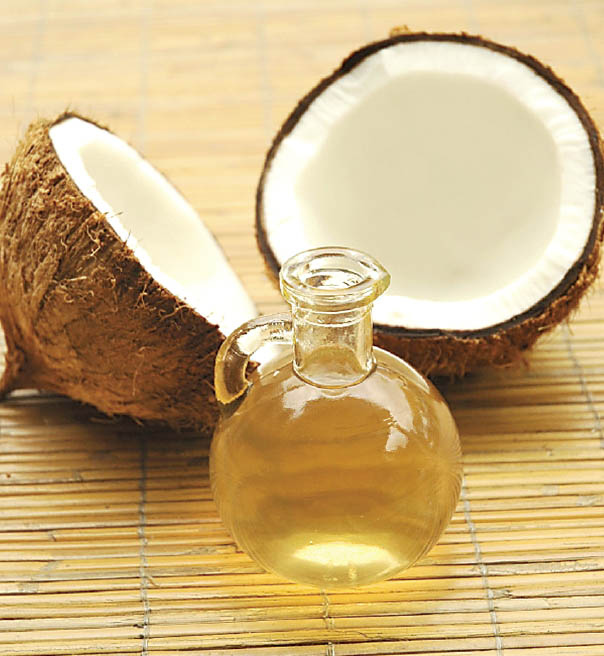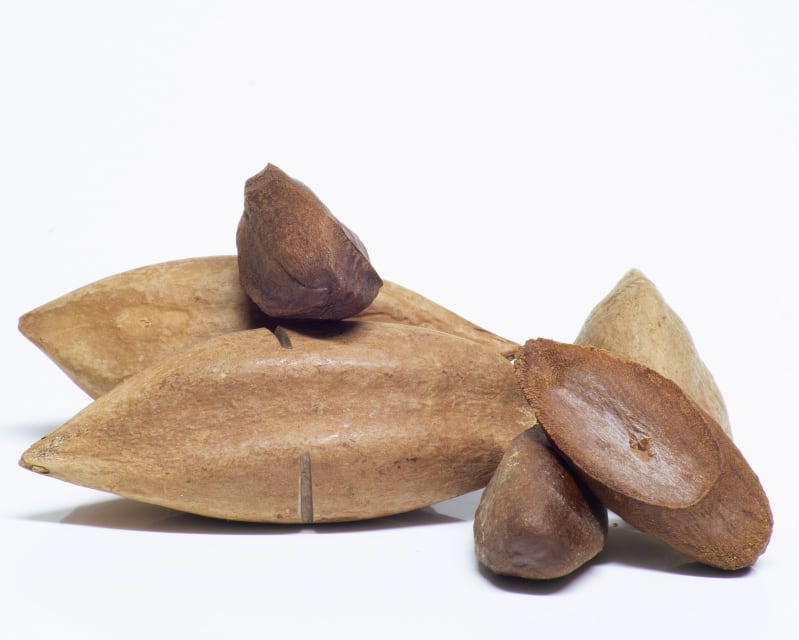Coconut Oil vs. Pili Nut
Nutrition comparison of Coconut Oil and Pili Nut
Ever wonder how your favorite foods stack up against each other in terms of nutrition?
We compared the nutritional contents of
coconut oil
versus
pili nut
(100g each)
below using 2020 USDA and NIH data[1].
For a quick recap of significant nutrients and differences in coconut oil and pili nut:
- Both pili nut and coconut oil are high in calories and saturated fat.
- Pili nut has more thiamin, riboflavin, niacin, pantothenic acid, Vitamin B6 and folate.
- Pili nut is a great source of protein.
- Pili nut is an excellent source of calcium, iron and potassium.
USDA sources for nutritional information: Coconut Oil (Oil, coconut) and Pili Nut (Nuts, pilinuts, dried) . Have a correction or suggestions? Shoot us an email.
Calories and Carbs
calories
Both pili nut and coconut oil are high in calories. Coconut oil has 24% more calories than pili nut - pili nut has 719 calories per 100 grams and coconut oil has 892 calories.
For macronutrient ratios, coconut oil is lighter in protein, heavier in fat and similar to pili nut for carbs. Coconut oil has a macronutrient ratio of 0:0:100 and for pili nut, 6:2:92 for protein, carbohydrates and fat from calories.
Macro Ratios from Calories:
| Coconut Oil | Pili Nut | |
|---|---|---|
| Protein | ~ | 6% |
| Carbohydrates | ~ | 2% |
| Fat | 100% | 92% |
| Alcohol | ~ | ~ |
carbohydrates
Both pili nut and coconut oil are low in carbohydrates - pili nut has 4g of total carbs per 100 grams and coconut oil does not contain significant amounts.
Protein
protein
Pili nut is a great source of protein and it has more protein than coconut oil - pili nut has 10.8g of protein per 100 grams and coconut oil does not contain significant amounts.
Fat
saturated fat
Both pili nut and coconut oil are high in saturated fat. Coconut oil has 164% more saturated fat than pili nut - pili nut has 31.2g of saturated fat per 100 grams and coconut oil has 82.5g of saturated fat.
trans fat
Both coconut oil and pili nut are low in trans fat - coconut oil has 0.03g of trans fat per 100 grams and pili nut does not contain significant amounts.
Vitamins
Vitamin C
Pili nut and coconut oil contain similar amounts of Vitamin C - pili nut has 0.6mg of Vitamin C per 100 grams and coconut oil does not contain significant amounts.
Vitamin A
Pili nut and coconut oil contain similar amounts of Vitamin A - pili nut has 2ug of Vitamin A per 100 grams and coconut oil does not contain significant amounts.
Vitamin E
Coconut oil and pili nut contain similar amounts of Vitamin E - coconut oil has 0.11mg of Vitamin E per 100 grams and pili nut does not contain significant amounts.
Vitamin K
Coconut oil and pili nut contain similar amounts of Vitamin K - coconut oil has 0.6ug of Vitamin K per 100 grams and pili nut does not contain significant amounts.
The B Vitamins
Pili nut has more thiamin, riboflavin, niacin, pantothenic acid, Vitamin B6 and folate.
| Coconut Oil | Pili Nut | |
|---|---|---|
| Thiamin | ~ | 0.913 MG |
| Riboflavin | ~ | 0.093 MG |
| Niacin | ~ | 0.519 MG |
| Pantothenic acid | ~ | 0.479 MG |
| Vitamin B6 | ~ | 0.115 MG |
| Folate | ~ | 60 UG |
Minerals
calcium
Pili nut is an excellent source of calcium and it has 144 times more calcium than coconut oil - pili nut has 145mg of calcium per 100 grams and coconut oil has 1mg of calcium.
iron
Pili nut is an excellent source of iron and it has 69 times more iron than coconut oil - pili nut has 3.5mg of iron per 100 grams and coconut oil has 0.05mg of iron.
potassium
Pili nut is an excellent source of potassium and it has more potassium than coconut oil - pili nut has 507mg of potassium per 100 grams and coconut oil does not contain significant amounts.
Omega-3 and Omega-6
omega 6s
Comparing omega-6 fatty acids, pili nut has more linoleic acid than coconut oil per 100 grams.
| Coconut Oil | Pili Nut | |
|---|---|---|
| other omega 6 | 0.076 G | ~ |
| linoleic acid | 1.683 G | 7.605 G |
| Total | 1.759 G | 7.605 G |
Customize your serving size
The comparison below is by common portions, e.g. cups, packages. You can also see a more concrete comparison by weight at equal weight (by grams) comparison.
Note: The specific food items compared are: Coconut Oil (Oil, coconut) and Pili Nut (Nuts, pilinuts, dried) .
Coconut Oil g
()
|
Daily Values (%) |
Pili Nut g
()
|
|||||
|---|---|---|---|---|---|---|---|
| KCAL % |
|
5% | calories | 5% |
|
KCAL % | |
| G % |
|
5% | carbohydrates | 5% |
|
G % | |
| G % |
|
5% | dietary fiber | 5% |
|
G % | |
| G | 5% | sugar | 5% | G | |||
| G % |
|
5% | total fat | 5% |
|
G % | |
| G % |
|
5% | saturated fat | 5% |
|
G % | |
| G | 5% | monounsaturated fat | 5% | G | |||
| G | 5% | polyunsaturated fat | 5% | G | |||
| G | 5% | trans fat | 5% | G | |||
| MG | 5% | cholesterol | 5% | MG | |||
| MG % |
|
5% | sodium | 5% |
|
MG % | |
| 5% | Vitamins and Minerals | 5% | |||||
| UG % |
|
5% | Vitamin A | 5% |
|
UG % | |
| MG % |
|
5% | Vitamin C | 5% |
|
MG % | |
| IU % |
|
5% | Vitamin D | 5% |
|
IU % | |
| MG % |
|
5% | calcium | 5% |
|
MG % | |
| MG % |
|
5% | iron | 5% |
|
MG % | |
| MG % |
|
5% | magnesium | 5% |
|
MG % | |
| MG % |
|
5% | potassium | 5% |
|
MG % | |
| MG % |
|
5% | thiamin (Vit B1) | 5% |
|
MG % | |
| MG % |
|
5% | riboflavin (Vit B2) | 5% |
|
MG % | |
| MG % |
|
5% | niacin (Vit B3) | 5% |
|
MG % | |
| MG % |
|
5% | Vitamin B6 | 5% |
|
MG % | |
| MG % |
|
5% | pantothenic acid (Vit B5) | 5% |
|
MG % | |
| UG % |
|
5% | folate (Vit B9) | 5% |
|
UG % | |
| UG % |
|
5% | Vitamin B12 | 5% |
|
UG % | |
| MG % |
|
5% | Vitamin E | 5% |
|
MG % | |
| UG % |
|
5% | Vitamin K | 5% |
|
UG % | |
| G % |
|
5% | protein | 5% |
|
G % | |
| UG % |
|
5% | biotin (Vit B7) | 5% |
|
UG % | |
| MG % |
|
5% | choline | 5% |
|
MG % | |
| MG % |
|
5% | chlorine | 5% |
|
MG % | |
| UG % |
|
5% | chromium | 5% |
|
UG % | |
| MG % |
|
5% | copper | 5% |
|
MG % | |
| UG % |
|
5% | fluoride | 5% |
|
UG % | |
| UG % |
|
5% | iodine | 5% |
|
UG % | |
| MG % |
|
5% | manganese | 5% |
|
MG % | |
| UG % |
|
5% | molybdenum | 5% |
|
UG % | |
| MG % |
|
5% | phosphorus | 5% |
|
MG % | |
| UG % |
|
5% | selenium | 5% |
|
UG % | |
| MG % |
|
5% | zinc | 5% |
|
MG % | |
| G | 5% | Water | 5% | G | |||
| G | 5% | Starch | 5% | G | |||
| G | 5% | Alcohol | 5% | G | |||
FAQ
Does pili nut or coconut oil contain more calories in 100 grams?Both pili nut and coconut oil are high in calories. Coconut oil has 20% more calories than pili nut - pili nut has 719 calories in 100g and coconut oil has 892 calories.
Does pili nut or coconut oil contain more calcium?
Pili nut is a rich source of calcium and it has 144 times more calcium than coconut oil - pili nut has 145mg of calcium in 100 grams and coconut oil has 1mg of calcium.
Does pili nut or coconut oil contain more iron?
Pili nut is an abundant source of iron and it has 69 times more iron than coconut oil - pili nut has 3.5mg of iron in 100 grams and coconut oil has 0.05mg of iron.
Does pili nut or coconut oil contain more potassium?
Pili nut is a rich source of potassium and it has more potassium than coconut oil - pili nut has 507mg of potassium in 100 grams and coconut oil does not contain significant amounts.

